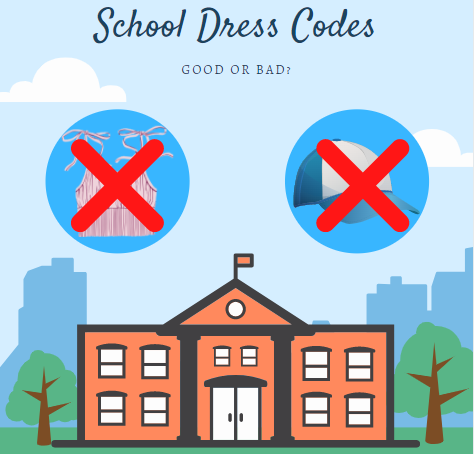THE PROBLEMS WITH DRESS CODES
Are dress codes causing more harm than good? IUP’s take on it.
Despite being a virtual school, many of iUniversity Prep’s students have had previous encounters with dress codes. Additionally, many brick-and-mortar schools have been struggling with enforcing dress codes since the return of students after quarantine. Considering their effects on certain marginalized groups, is it safe to say that school dress codes cause more harm than good?
Can students have positive experiences regarding dress codes?
Not all dress codes are bad and many students can go through their school years without having any issues. For instance, at Kendall Myers’ former school, the dress code was basic and she “didn’t find any conflict when attending the school when it [came] to apparel.” Brooke Bolinger was able to look on the bright side when it came to dress codes, noting that “The dress code was a good conduct to follow because [without it] many girls (and guys) would choose to wear very inappropriate clothes.”
The downsides of dress codes
Unfortunately, many have had some not-so-great experiences with dress codes. One anonymous student said they did not personally have any issues with their school’s dress code, but knew many people who did. This student said, “I personally did not have any problems with it [the dress code], however, that was not the case with the upperclassmen. Particularly in middle school, people I knew got dress-coded every day even though they were not wearing anything offensive. It definitely is very biased as the boys don’t get dress coded as often even though they wear inappropriate clothing at times. At every public school I’ve seen, girls get dress coded more and have stricter guidelines.” Unfortunately, many schools have dress codes that censor female students, and this can cause issues among that particular group of students. Female students get dress-coded all the time for wearing clothes that “distract” other students from learning, however, getting dress-coded is much more distracting than simply seeing a peer wearing a bold piece of clothing.
One of iUP’s students, Hayden, is very passionate about this topic. Here is what they had to say: “I think dress codes are completely unfair and biased towards people who identify as female. In lots of schools, the dress code isn’t general and only applies to a certain group of students. In my opinion, it singles out students and enforces gender roles. When a student is ‘dress coded’ it singles them out and can feel really embarrassing. Enforcing dress code has been another issue lately as well. During Covid-19, schools claimed that they couldn’t force students to wear masks. So why can they enforce dress code? Instead of rules like ‘shorts can’t go past your fingertips,’ there should be a set length or more general rules. It’s hard to figure these things out because of course, we want students to be dressed ‘appropriately’, but at the same time, it is NOT one student’s job to dress in a way that won’t ‘distract’ other students. Some people believe uniforms are a solution to this problem. I agree, to a certain degree. If schools provided uniforms it would make it easier to not have to enforce or even have a dress code. Dress code is a flawed idea and needs serious revision or a new look altogether.” Adding on to what Hayden said about the issues with enforcing dress code this year, the leniency during the 2020-2021 school year has caused problems in this school year. During the 2020-2021 school year, schools were just happy to have students back in the buildings, so they didn’t enforce the dress code rules intensely. As a result, students were allowed to wear clothing that may have been deemed against the dress code. In this school year, administrators have gone back to strictly enforcing the dress code, causing lots of backlash from students who were allowed to wear hats and tank tops in the previous school year. Many other iUP students that I interviewed agreed that dress codes cause more harm than good. Because they come with double standards and can have negative impacts on students, dress codes need to undergo some changes if they are going to stay in place.
Attending other schools for testing
Even though the iUP students can do their learning from home, standardized testing requires us to go into other schools a few days each school year. According to a survey I held, most iUP students try to follow the school’s dress code in hopes of avoiding conflict. An anonymous student had an interesting stance on the topic, saying, “I do not personally follow other schools’ dress codes. I still wear respectful clothing, however, I am not enrolled in that school, so it is not up to them to tell me what to wear.”
My opinion
I think that today’s standards for dress codes are biased towards female-identifying students. For example, many schools prohibit certain types of tank tops, such as spaghetti strap-tops. Their reasoning for said policies is usually something like, “shoulders are distracting for other students”. Although some schools establish dress codes for safety reasons, I believe that many schools only have anti-feminine dress codes because it makes life easier for teachers dealing with teenage boys who have no self-control. Since I have attended iUP for many years, I have gone to testing sites a handful of times for STAAR tests, the PSAT, etc. Even when I tested at the GCISD locations specifically for iUP students, I would try to dress in a way that would adhere to a general dress code. Recently, I did not test at a GCISD location and tried to dress in accordance with the district’s dress code to the best of my ability to avoid getting sent home and being unable to take my test. In fact, I even Googled the school’s dress code to ensure there would be no issues. On test day, the dress code should be the least of a student’s worries. However, with the risk of getting sent home for going against the dress code, it can become something to dwell on.
Conclusion
Dress codes can sometimes be necessary, but in recent years they have become a controversial topic. Thankfully, most students are indifferent about it, but maybe some changes need to be made so that they’re fair for everyone.

My name is Makenna Horne and this is my 6th and final year at IUP! This is my 2nd year in iHoot and I’m so happy to be a part of the BOE! I love doing...








Anika Goswami • Apr 28, 2022 at 3:09 pm
Before I read this article, I had no idea about these issues. This was very informative, and I appreciate you writing it, Makenna! Great work!
Autumn Friesenhahn • Apr 8, 2022 at 10:11 am
When I was in B&M, I usually wore dresses to the first day of school. I was wearing a green spaghetti strap dress to second grade, and I wore this white, soft jacket with it. In AUGUST. Because I couldn’t show my straps. It’s SECOND GRADE, people. And then, in 4th grade, one of the boys in my class would wear this Fortnite T-shirt that creeped everyone out during class, and no one ever told him not to wear it!
In the article, it says that these dress codes may be so teachers can control the boys better. That is not the way to teach them self-control. They will never learn it unless they are in a situation where they must practice it.
Makenna Horne • Apr 9, 2022 at 9:18 pm
You are so right Autumn! Thank you for your comment and thank you for reading my article!
Autumn Friesenhahn • Apr 11, 2022 at 11:01 am
Welcome! Thank YOU for writing it! I never knew about this!
Autumn Friesenhahn • Apr 8, 2022 at 9:54 am
I agree!
Kendall • Mar 1, 2022 at 3:47 pm
This was such a great article idea and topic! I can definitely see where people are coming from on this topic and as you mentioned it’s a “controversial topic”. Overall, it was interesting to see the different opinions of others. I really enjoyed this article, Makenna!
Makenna Horne • Mar 10, 2022 at 12:18 pm
Thank you so much Kendall!